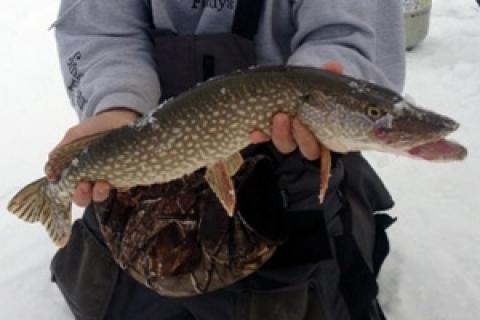
 Out of all the different ways you can catch pike through the ice, jigging has to be one of my favorites. Jigging pike is simple and really requires a very basic set up. No bait, tip ups or fancy setups needed. If you can figure out the movement of pike and learn a couple simple jigging techniques, winter pike are easy prey.
Out of all the different ways you can catch pike through the ice, jigging has to be one of my favorites. Jigging pike is simple and really requires a very basic set up. No bait, tip ups or fancy setups needed. If you can figure out the movement of pike and learn a couple simple jigging techniques, winter pike are easy prey.
To understand why pike are such good targets for ice jigging, anglers need to understand the mindset pike have. Since they are a group of fish that spawn early in the spring (right after ice out), pike can never take a break feeding throughout the winter. If you can understand what these pike want to feed on and where these baitfish are during the winter months ice anglers can catch pike all season long.
In the early season, look for pike to be where you can find green weeds. These weeds produce much needed oxygen that small fish and aquatic invertebrates need to survive. When these forage fish take up residence in good numbers, pike, and other game fish, won't be far away. Pike will actively search these weed for any baitfish that makes the mistake of not finding good cover. As the season advances and the snow gets deeper, the light that reaches the lake bottom gets less. With this lack of light, weed growth and oxygen levels will be on the decline. Baitfish will spread out and pike will abandon these feeding areas soon after. Pike will move to deeper water and suspend off structure like rocks or wood again looking for baitfish. In the late season pike will return to the shallows to find potential spawning areas.
To catch pike, ice anglers have to be active and mobile. Drilling lots of holes in the ice and covering water is the key. Look for signs of baitfish and weed growth, then actively jig these spots to trigger pike. The process is pretty straight forward: drill a hole, drop your electronics and jig for five to 10 minutes. The jigging action should be a quick raise and drop motion. You want the lure to dart and flutter as it falls from each pop. A good idea is to also mix up your jigging lengths. In most cases, raising and dropping the lure 3-4 inches is normal, but throwing in a raise of a foot or two every now can get cautious pike into biting.
When we think of jigging for pike, spoons are the best baits for the job. Spoons come in various shapes, sizes and almost any color you can think of. For most purposes, flutter spoons is what you should be looking for. These spoons fall at a slow rate and dance the whole way down. If you plan on fishing deeper water, use solid spoons which allow you to control your bait throughout the water column.
Take the time to chase some pike this winter with the jigging pole. Jigging with spoons will allow you to cover more water and fish both shallow and deep water in your search for big pike. The jigging motion triggers pike for larger distances than live bait, and help initiate their opportunistic attitude even when they are in a negative mood.
![]() Choosing the Perfect Ice-Fishing Rod
Choosing the Perfect Ice-Fishing Rod
- 8016 views

